


 More photos
More photosDandong is a city at Liaoning Province of the Northeastern part of China. This part of China in general and this city in particular, has more than 4,000 years of history. This city is at the frontier of Northeast China, separated from North Korea, by Yalu River. It has about 2.5 million inhahitants, about one third live in the city, while the rest live in rural area. Until 10 years ago, agriculture was the main income generating sector, but it has transformed itself into a city which produces manufacturing goods, and also the city is now flourish with businesses related to service sector. Tourism has become an important source of income for the city too. Tourist spots include the eastern start of the Great Wall, White Stone Natural Reserves, Wulongbei Hot Spring, Phoenix Mountain, etc.
China's open door policy and market-oriented economic policy have indeed produced higher income, and thus higher living standards for its people. Dandong is a typical success story in China's impressive growth record. Per capita income in Dandong is more than 12,000 Yuan (2005, which is more than US$1,500).
The town across Yalu River is known as Sinuiju. Dandong-Sinuiju-Yalu River was the front line battle ground between the U.S. soldiers and Chinese People Liberation Army in 1951-52. A few years ago, the Great Leader of North Korea has designated Sinuiju as a Special Economic Zone for attracting foreign direct investment into his cash hungry country. However, the concept did not take-off for the Great Leader thinks developing nuclear weapons bring more benefits than allocating resources and attentions to promoting economic activities.
As a result, the disparity of economic well being of these two cities, and their landscapes, are in great contrast. The first two photos exhibit high rise buildings, a reflection of Dandong's economic growth, whereas the last two illustrate that Sinuiju is still trapped in subsistence economy (which remains as a fishery and an agriculture-oriented). Port facilities and boats are obsolete, and if observe carefully, one wonders how fishermen could use them productively and safely. Instead, perhaps, one might think they are being used as camouflage for illicit activities such as...... (you imagine).
About 30 years ago, similar contrasting view was observed in Shenzen (an agriculture and fishery village then) and Hong Kong. But now, that city has the highest per capita income in China. That transformation is an undisputed result of the power of openness and market principles. Alas, the Great Leader believes that a nuclear warhead is far powerful than the power of openness and economic incentives for his hermit kingdom.

No comments:
Post a Comment